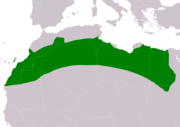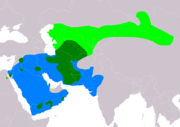
Bustards, including floricans and korhaans, are large, terrestrial birds living mainly in dry grassland areas and on the steppes of the Old World. They range in length from 40 to 150 cm. They make up the family Otididae.
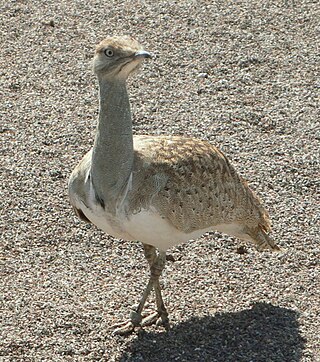
The houbara bustard, also known as African houbara, is a relatively small bustard native to North Africa, where it lives in arid habitats. The global population is listed as Vulnerable on the IUCN Red List since 2014. There is a population in the Canary Islands which has been assessed as Near Threatened in 2015.
Desert National Park is a national park in the Indian state of Rajasthan, near the towns of Jaisalmer and Barmer. It is one of the largest national parks, covering an area of 3,162 km2 (1,221 sq mi) in the Thar Desert. Sand dunes form around 44% of the park. The major landform consists of craggy rocks and compact salt lake bottoms, intermedial areas and fixed dunes. It was gazetted in 1980.

The great Indian bustard or Indian bustard is a bustard occurring on the Indian subcontinent. It is a large bird with a horizontal body and long bare legs, and is among the heaviest of the flying birds. Once common on the dry grasslands and shrubland in India, as few as 150 individuals were estimated to survive as of 2018, reduced from an estimated 250 individuals in 2011. It is critically endangered due to hunting and habitat loss. It is protected under the Indian Wild Life (Protection) Act, 1972.
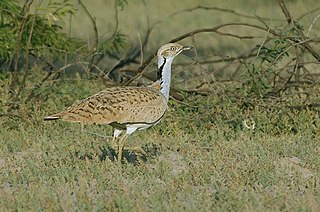
MacQueen's bustard is a large bird in the bustard family. It is native to the desert and steppe regions of Asia, west from the Sinai Peninsula extending across Kazakhstan east to Mongolia. In the 19th century, vagrants were found as far west of their range as Great Britain. Populations have decreased by 20 to 50% between 1984 and 2004 mainly due to hunting and changes in land-use. MacQueen's bustard is a partial latitudinal migrant while the houbara bustard is more sedentary. Both species are the only members of the genus Chlamydotis. MacQueen's bustard used to be regarded as a subspecies of the houbara bustard and known as the "Asian houbara".

The Australian bustard is a large ground-dwelling bird that is common in grassland, woodland and open agricultural country across northern Australia and southern New Guinea. It stands at about one metre high, and its wingspan is around twice that length. The species is nomadic, flying to areas when food becomes plentiful, and capable of travelling long distances. They were once widespread and common to the open plains of Australia, but became rare in regions that have been used for farming. The bustard is omnivorous, mostly consuming the fruit or seed of plants, but also eating invertebrates such as crickets, grasshoppers, smaller mammals, birds and reptiles.

The Arabian bustard is a species of bustard which is found across the Sahel region of Africa and south western Arabia. It is part of the large-bodied genus, Ardeotis, and, though little known, appears to be a fairly typical species in that group.

The southern black korhaan, also known as the black bustard, is a species of bird in the bustard family, Otididae. This small bustard is found in southwestern South Africa, from Namaqualand, south to Cape Town and east to Makhanda. It prefers semi-arid habitats such as grasslands, shrublands and savannas where it can easily prey on ground-dwelling arthropods and eat seeds. It reproduces yearly in the spring and will lay about one or two eggs per breeding season.

The buff-crested bustard is a medium-sized bird of East Africa belonging to the family Otididae. The populations are stable and the species is of least concern.
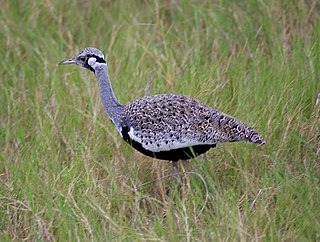
Hartlaub's bustard is a species of bird in the family Otididae. It is found in open grassland with grass up to 1800 meters in Ethiopia, Kenya, Somalia, Sudan, Tanzania, and Uganda.

Savile's bustard is a species of bird in the family Otididae. Otididae are an Old-World and understudied family of birds mostly found in Afro-Tropical regions. It is found in Burkina Faso, Cameroon, Chad, Ivory Coast, Gambia, Mali, Mauritania, Niger, Nigeria, Senegal, and Sudan.

The blue-browed tanager is a species of bird in the family Thraupidae. It is found in Bolivia, Colombia, Ecuador, and Peru. Its natural habitat is subtropical or tropical moist montane forests.

Otis is a genus of bustard containing a single living species, the great bustard (Otis tarda).

The North Saharan steppe and woodlands is a desert ecoregion, in the deserts and xeric shrublands biome, that forms the northern edge of the Sahara. It extends east and west across Northern Africa, south of the Mediterranean dry woodlands and steppe ecoregion of the Maghreb and Cyrenaica, which is part of the Mediterranean forests, woodlands, and scrub biome. Winter rains sustain shrublands and dry woodlands that form an ecotone between the Mediterranean climate regions to the north and the hyper-arid Sahara Desert ecoregion to the south.

Kutch Bustard Sanctuary or Kachchh Great Indian Bustard Sanctuary, also known as Lala–Parjan Sanctuary, is located near Jakhau village in Taluka Abdasa, Gujarat, India. This sanctuary is one of the two great Indian bustard sanctuaries in Gujarat; the other one is in Jamnagar. It was declared as a sanctuary in July 1992, specifically for the conservation of the great Indian bustard, the heaviest flying bird belonging to the avian family of Otididae. However, the sanctuary presently legally covers a protected area of about 2 square kilometres (0.77 sq mi) of area (202.86 hectares of fenced land only and is the smallest sanctuary in the country. Several suggestions have been made to vastly increase the size of this sanctuary as it is a breeding ground of the endangered great Indian bustard. The reason is that its ecological zone is much larger on account of anthropogenic and cattle population pressure that are considered as a ‘biotic threat’ to this omnivorous species.

The great bustard is a bird in the bustard family, and the only living member of the genus Otis. It breeds in open grasslands and farmland from northern Morocco, South and Central Europe to temperate Central and East Asia. European populations are mainly resident, but Asian populations migrate farther south in winter. Endangered as of 2023, it had been listed as a Vulnerable species on the IUCN Red List since 1996.
Jebil is a national park in Tunisia situated within the Sahara desert. Covering an area of 150,000 hectares, it is the country's second-largest national park, after Senghar-Jebbes National Park. Though large, it is relatively new having been designated a national park in 1994. Until Senghar-Jebbes was declared, Jebil was the only national park within the Sahara desert proper.
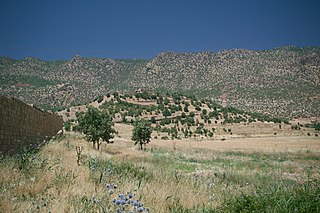
The Middle East steppe ecoregion stretches in an arc from southern Jordan across Syria and Iraq to the western border of Iran. The upper plains of the Tigris and Euphrates Rivers dominate most of the ecoregion. The terrain is mostly open shrub steppe. The climate is arid. Evidence is that this region was once more of a forest-steppe, but centuries of overgrazing and gathering firewood have reduced tree and grass cover to small areas and along the riverine corridors. Despite the degraded condition of the steppe environment, the ecoregion is important for water birds as the rivers and reservoirs provide habitat in the arid region.
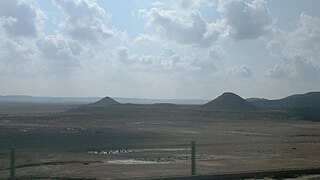
The Mesopotamian shrub desert is a deserts and xeric shrublands ecoregion in Western Asia. It extends across portions of Israel, Jordan, Syria, Iraq, and Iran.


